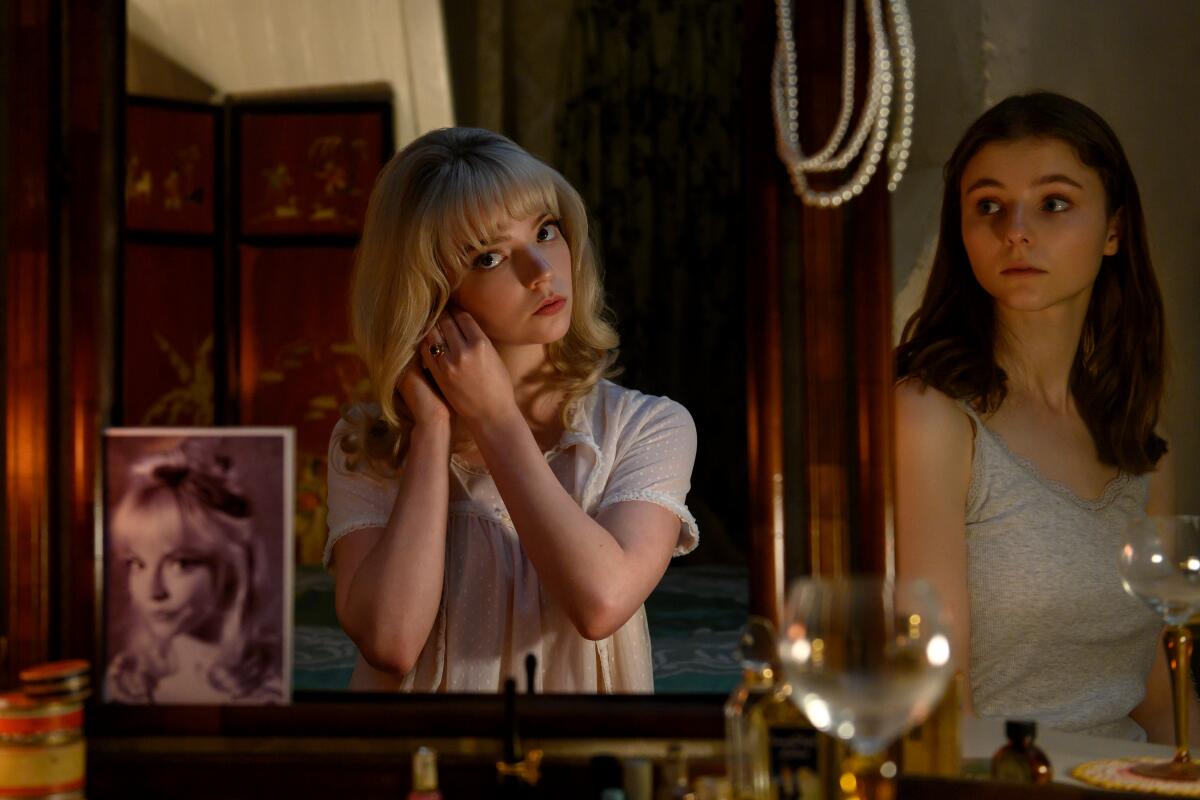Review: A visual and aural feast, Edgar Wright’s ‘Last Night in Soho’ has a few wobbles

- Share via
The Times is committed to reviewing theatrical film releases during the COVID-19 pandemic. Because moviegoing carries risks during this time, we remind readers to follow health and safety guidelines as outlined by the Centers for Disease Control and Prevention and local health officials.
Can nostalgia offer history a brighter, more exciting and decidedly rose-colored sheen? This is the question filmmaker Edgar Wright and co-writer Krysty Wilson-Cairns pick up in “Last Night in Soho,” a neon-drenched, blood-soaked trip through the swinging ‘60s of London, as experienced through modern eyes. In this giallo-inspired psychological slasher film, Wright and Wilson-Cairns explore the psychic connection between the past and the present, investigating the spirits that haunt the spaces we occupy. It’s a colorful, hallucinatory throwback, and a wild ride through the mind.
The modern eyes of “Last Night in Soho” belong to Eloise Turner (Thomasin McKenzie), a young fashion student from Cornwall obsessed with vintage 1960s music and fashion, venturing to the big city for the first time to attend college. Her grandmother (kitchen-sink cinema icon Rita Tushingham) is worried about her sensitive granddaughter, as Ellie is attuned to other planes of spectral existence, frequently visited by visions of ghosts, including her mother.
For ‘Last Night in Soho,’ Edgar Wright’s horror-thriller starring Thomasin McKenzie and Anya Taylor-Joy, filmmakers drew inspiration from other films.
Ellie is determined to hack it in London, but her horrible roommate and dorm shenanigans drive her to rent a room from an older woman, Ms. Collins (the dearly departed Diana Rigg). The room, which countless girls have rented over the years, has vintage charm and a flashing neon French bistro light outside its window, setting the surreal scene for Ellie to dive into her psychic, psychedelic dream world. She encounters Sandie (Anya Taylor-Joy), a fetching young blonde from the mid-’60s with big dreams and an even bigger bouffant. With winged eyeliner out to there, Sandie’s got all the swaggering confidence that Ellie doesn’t, and stepping into her perfectly soignée shoes for an evening is powerfully intoxicating, until Sandie’s ultra-cool existence becomes a nightmare.
If “Last Night in Soho” was just a guise to get the luminous Taylor-Joy to shake a tailfeather while clad in period costumes, it would be worth the price of admission. Indeed, the film’s most pleasurable moments are the expressionistic sequences when Sandie hits the dance floor with abandon, though she attracts all kinds of unsavory men, including her manager, Jack (Matt Smith).
These dream scenes in which Ellie and Sandie become doubles, seen only in mirrored reflections, are stunning achievements of filmmaking, especially the dizzying configurations of choreography, blocking, editing, and long, swooping camera movements that place Sandie and Ellie in the same shot, whirling across the dance floor, trading places. Park Chan-wook’s longtime cinematographer, Chung-hoon Chung, makes “Last Night in Soho,” without a doubt, the best-looking film of Wright’s career.
Wright is a reverent film fanatic first and foremost, and of course he would write in the great British stars of the era, including juicy roles for such icons as Terence Stamp, as a local barfly at the pub where Ellie works, and Rigg, in a fantastic last performance (the film is dedicated “for Diana”) as the intimidating landlady.
As Ellie’s reality starts to blur between the past and present, and the violence of Sandie’s broken dreams infects her mind, her mental state starts to spiral out of control. McKenzie’s performance becomes increasingly histrionic at a level that’s challenging to sustain, though her hysteria provides an apt foil for the always composed Sandie and the tough-as-nails Ms. Collins. But when the film ventures away from dazzling practical spectacle and enters the realm of computer-generated ghouls, it loses a bit of its magic and takes on a cheesy “Doctor Who” vibe — perhaps intended — though the effect eventually wanes.
The cinematography, soundtrack and sumptuous costumes by Odile Dicks-Mireaux create an impeccable aesthetic, but the overstuffed story of “Last Night in Soho” wobbles toward the end. This postmodern feminist horror film reimagines an era that objectified women, but as the stakes escalate, the film’s moralities, and loyalties, start to waver. This visual and aural feast does have a stumble or two on the dance floor, though in the 11th hour, Wright manages to right the ship, with an assist from the ever-reliable Taylor-Joy.
Katie Walsh is a Tribune News Service film critic.
‘Last Night in Soho’
Rated: R, for bloody violence, sexual content, language, brief drug material and brief graphic nudity
Running time: 1 hour, 56 minutes
Playing: Starts Oct. 29 in general release
More to Read
Only good movies
Get the Indie Focus newsletter, Mark Olsen's weekly guide to the world of cinema.
You may occasionally receive promotional content from the Los Angeles Times.










